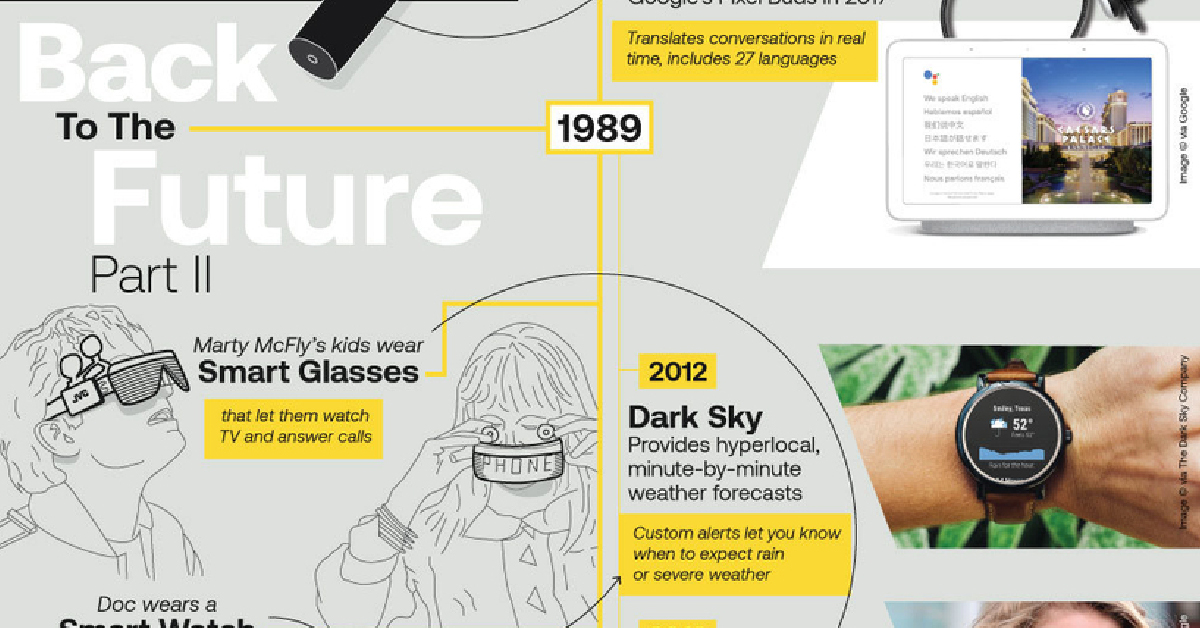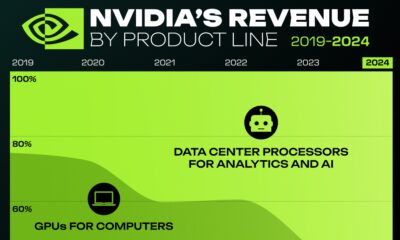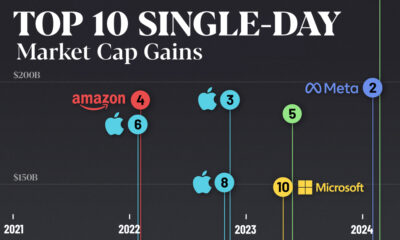Technology
A Visual Timeline of AI Predictions in Sci-Fi
They say you shouldn’t believe everything you see on the big screen.
However, in the case of science fiction, the human imagination has gotten a few things right—especially when it comes to futuristic forecasts. Today, the artificial intelligence (AI) revolution is transforming everything, but it turns out we had a hunch about it all along.
When AI Comes to Life
Today’s infographic from Noodle.ai takes a look at how some movie and television predictions for AI’s capabilities have taken hold in the real world.

Many early “predictions” about future technologies certainly missed the mark—but it seems science fiction was able to accurately forecast a thing or two about AI.
AI Basics: Making Life Better
Artificial intelligence is all about equipping machines with the ability to mimic human decision-making processes. It has a wide range of applications, from basic automation to advanced machine learning models.
AI has proliferated into virtually every aspect of life, and in the graphic, it’s clear that several sci-fi-turned-real inventions are aimed at making things more convenient for us humans.
| Sci Fi Prediction | AI in Reality |
|---|---|
| 1962: The Jetsons cartoon shows video calls on a tv screen, and a robot maid. | 2002: iRobot Roomba is the first robotic vacuum. 2018: Facebook Portal is a video-calling smart display. 2019: Moley robotic kitchen is able to prep meals from scratch and clean up afterwards. |
| 1966: Star Trek inspired several tech innovations that have become commonplace. | Examples include: Bluetooth headsets, voice assistants, cellphones, and automatic sliding doors. |
| 1989: Back to the Future features smart glasses for television and phone calls, and a smart watch which can precisely predict weather. | 2012: The Dark Sky app provides custom alerts on the weather to the minute. 2013: Google Glass is able to make calls, send texts, display photos, and provide directions. 2015: Apple Watch comes enabled with WiFi, Bluetooth, a GPS, and even a heart sensor. |
| 1999: Smart House showcases a fully automated house that is able to respond to verbal requests, cook and clean, and control thermostat settings. | 2019: A HGTV contest lets people win a WiFi connected smart house, complete with voice-enabled thermostat and security systems. |
Of course, these have had varying degrees of success. While Google Glass didn’t initially resonate with the wider public, the augmented reality smart glasses have now proved useful in businesses such as manufacturing.
Elsewhere, sci-fi-inspired advances in industries like healthtech are providing a new lease of life for many patients—and continuously reinventing the frontier of what we think is possible.
Sci-Fi Helps Us Push Boundaries
One monumental event in AI history occurred in 1997, when IBM’s Deep Blue beat a chess master at his own game. This event shook the world when we realized what AI could truly be capable of—even though sci-fi had in fact anticipated it 20 years prior.
But as the graphic shows, not all is rosy in science fiction’s likeness of AI. It’s often depicted as something to fear, and certain predictions have proved to be eerily accurate.
| Sci Fi Prediction | AI in Reality |
|---|---|
| 1977: K9, a robotic dog in Doctor Who, beats its master at a chess game. | 1997: IBM’s Deep Blue computer beats a Russian chess master, Garry Kasparov. |
| 1984: Skynet from Terminator, a self-aware AI program, attempts to extinguish humanity. | 2019: The U.S. Army creates an autonomous system to “acquire, identify, and target threats” (ATLAS AI). |
| 2011: AI monitors surveillance cameras and predicts future criminals in Person of Interest. | 2018: The National Data Analytics Solution (NDAS) |
While not all of these are causes for alarm, they clearly demonstrate that sci-fi has the capacity to influence the breakthrough technology we could end up seeing a few years down the line. However, turning reel to real can raise some curious dilemmas.
Rights for Robots?
Last year, the European Parliament debated an interesting question: do robots qualify as people?
The resolution considered granting “personhood” to sophisticated, autonomous robots. However, over 150 AI experts strongly warned against this proposal, arguing it would “blur the relation between man and machine” in a way that is too unethical.
Nevertheless, this thought experiment proves that artificial intelligence is matching our wildest imagined predictions for it.
AI is whatever hasn’t been done yet.
—Tesler’s Theorem
As we move ever closer towards a world where AI is inextricably linked with the everyday, how else could science fiction shape our expectations of the future?
Technology
Ranked: Semiconductor Companies by Industry Revenue Share
Nvidia is coming for Intel’s crown. Samsung is losing ground. AI is transforming the space. We break down revenue for semiconductor companies.
Semiconductor Companies by Industry Revenue Share
This was originally posted on our Voronoi app. Download the app for free on Apple or Android and discover incredible data-driven charts from a variety of trusted sources.
Did you know that some computer chips are now retailing for the price of a new BMW?
As computers invade nearly every sphere of life, so too have the chips that power them, raising the revenues of the businesses dedicated to designing them.
But how did various chipmakers measure against each other last year?
We rank the biggest semiconductor companies by their percentage share of the industry’s revenues in 2023, using data from Omdia research.
Which Chip Company Made the Most Money in 2023?
Market leader and industry-defining veteran Intel still holds the crown for the most revenue in the sector, crossing $50 billion in 2023, or 10% of the broader industry’s topline.
All is not well at Intel, however, with the company’s stock price down over 20% year-to-date after it revealed billion-dollar losses in its foundry business.
| Rank | Company | 2023 Revenue | % of Industry Revenue |
|---|---|---|---|
| 1 | Intel | $51B | 9.4% |
| 2 | NVIDIA | $49B | 9.0% |
| 3 | Samsung Electronics | $44B | 8.1% |
| 4 | Qualcomm | $31B | 5.7% |
| 5 | Broadcom | $28B | 5.2% |
| 6 | SK Hynix | $24B | 4.4% |
| 7 | AMD | $22B | 4.1% |
| 8 | Apple | $19B | 3.4% |
| 9 | Infineon Tech | $17B | 3.2% |
| 10 | STMicroelectronics | $17B | 3.2% |
| 11 | Texas Instruments | $17B | 3.1% |
| 12 | Micron Technology | $16B | 2.9% |
| 13 | MediaTek | $14B | 2.6% |
| 14 | NXP | $13B | 2.4% |
| 15 | Analog Devices | $12B | 2.2% |
| 16 | Renesas Electronics Corporation | $11B | 1.9% |
| 17 | Sony Semiconductor Solutions Corporation | $10B | 1.9% |
| 18 | Microchip Technology | $8B | 1.5% |
| 19 | Onsemi | $8B | 1.4% |
| 20 | KIOXIA Corporation | $7B | 1.3% |
| N/A | Others | $126B | 23.2% |
| N/A | Total | $545B | 100% |
Note: Figures are rounded. Totals and percentages may not sum to 100.
Meanwhile, Nvidia is very close to overtaking Intel, after declaring $49 billion of topline revenue for 2023. This is more than double its 2022 revenue ($21 billion), increasing its share of industry revenues to 9%.
Nvidia’s meteoric rise has gotten a huge thumbs-up from investors. It became a trillion dollar stock last year, and broke the single-day gain record for market capitalization this year.
Other chipmakers haven’t been as successful. Out of the top 20 semiconductor companies by revenue, 12 did not match their 2022 revenues, including big names like Intel, Samsung, and AMD.
The Many Different Types of Chipmakers
All of these companies may belong to the same industry, but they don’t focus on the same niche.
According to Investopedia, there are four major types of chips, depending on their functionality: microprocessors, memory chips, standard chips, and complex systems on a chip.
Nvidia’s core business was once GPUs for computers (graphics processing units), but in recent years this has drastically shifted towards microprocessors for analytics and AI.
These specialized chips seem to be where the majority of growth is occurring within the sector. For example, companies that are largely in the memory segment—Samsung, SK Hynix, and Micron Technology—saw peak revenues in the mid-2010s.
-

 Maps2 weeks ago
Maps2 weeks agoMapped: Average Wages Across Europe
-

 Money1 week ago
Money1 week agoWhich States Have the Highest Minimum Wage in America?
-

 Real Estate1 week ago
Real Estate1 week agoRanked: The Most Valuable Housing Markets in America
-

 Markets1 week ago
Markets1 week agoCharted: Big Four Market Share by S&P 500 Audits
-

 AI1 week ago
AI1 week agoThe Stock Performance of U.S. Chipmakers So Far in 2024
-

 Automotive2 weeks ago
Automotive2 weeks agoAlmost Every EV Stock is Down After Q1 2024
-

 Money2 weeks ago
Money2 weeks agoWhere Does One U.S. Tax Dollar Go?
-

 Green2 weeks ago
Green2 weeks agoRanked: Top Countries by Total Forest Loss Since 2001














